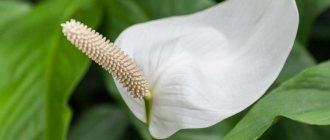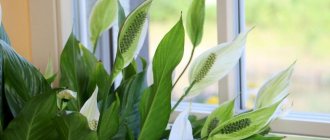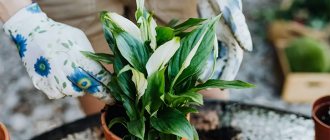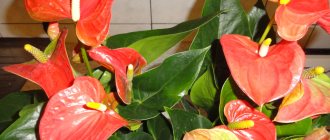In recent years, Spathiphyllum, or as it is more often called, Women's Happiness, has consistently been one of the most popular indoor plants. The flower owes this to both its appearance and its ease of care.
This tall herbaceous plant with wide, pointed leaves of a rich dark green hue can be found in offices, apartments and even country residences.
It is believed that Spathiphyllum has a magical aura that allows girls to find love. The plant is also credited with some healing properties. For example, it helps to cope with diseases of the nervous system and has a beneficial effect on the atmosphere indoors.
What kind of culture is this?
Biological description
Spathiphyllum is a perennial plant, a member of the genus Anthurium.
Appearance
Spathiphyllum is an evergreen plant . It can have different heights from miniature ones of 20 cm to large specimens of one meter. The plant stands out for its spectacular and beautiful flowering.
With good care, some types of spathiphyllum can bloom for almost a whole year.
Read about spathiphyllum organs, diseases and pests of the flower here.
What does it look like in the photo?
Here you can see photographs of the flower of female happiness or spathiphyllum.
Passport
- Light : bright place, light partial shade.
- Temperature : optimal temperature 22-23 degrees.
- Watering : abundant from spring to autumn, more moderate in winter. Does not tolerate stagnation of water in the roots.
- Humidity : needs high humidity.
Country of origin
The birthplace of this plant is considered to be South America, East Asia, and Polynesia. In nature, spathiphyllum grows in damp and warm places : along the banks of rivers and streams, in swampy places. They began to use it as a houseplant only in the 60s of the 20th century.
Read more about who discovered spathiphyllum and what its country of origin is here.
Major organs
Spathiphyllum inflorescences have an unusual shape - in the form of a cob and a white petal growing at the base. The cob itself has different shades depending on the type. The plant has a short rhizome and no stem. The leaves grow directly from the ground and are usually oval in shape with a pointed tip and a prominent midrib. This is typical for tropical areas.
Plant structure
Roots
The plant has a shortened rhizome, which it needs to receive nutrients from the soil.
In the wild, Spathiphyllum grows in the tropics on marshy soils. Therefore, at home you need to get closer to the conditions of the plant’s natural habitat.
Spathiphyllum prefers a substrate made of humus, sand and peat. You can prepare the mixture yourself by adding leaf soil and turf. If you are growing a flower for the first time, it is better to purchase a ready-made substrate in the store. Suitable soil for Aroids.
The root system of the plant is very sensitive to the watering regime. You need to add water regularly, but only when the top layer of soil dries. Please note that excessive watering of spathiphyllum causes the water in the pot to stagnate. In turn, this leads to rotting of the root system. The plant dies.
To prevent this from happening, the soil must be loosened. This will ensure air flow to the roots. By the way, the root system of Spathiphyllum is very easy to damage, so be extremely careful.
INTERESTING! Spathiphyllums, epiphytes, are found in the wild. This means that they do not need soil to grow. They can grow, for example, on trees. But all domestic varieties are terrestrial, so they need to be grown in a pot.
Leaves
A distinctive feature of Women's Happiness is its large beautiful leaves. They are mostly dark green, although there are varieties (Picasso, Domino) with variegated leaf blades.
Like most Araceae, the leaves of this plant have distinct petioles, which are approximately equal in length to the leaf blades themselves.
On average, the leaf size of an adult plant is about 50-70 cm. The shape of the leaves of Women's Happiness can be oval, ovoid or lanceolate.
The veins are clearly visible on the leaf plate. The central one is slightly thicker and is like a continuation of the petiole.
Old Spathiphyllum leaves bend towards the ground, while young ones are almost erect.
INTERESTING! If you notice a drop of water on the tip of a Spathiphyllum leaf, this indicates excessive watering. The soil in the pot under the plant must be loosened and the water must be poured out of the pan.
Cover
During flowering, a white leaf blooms on the long peduncle of Women's Happiness. This is not a flower, but a “veil” that directly covers the inflorescence itself. The “bedspread” is usually a soft white color. It is smaller in size than the main leaves.
INTERESTING! The snow-white blanket gave another name to Spathiphyllum - White Sail.
Flowers
Another distinctive feature of Women's Happiness is its inflorescence. It is a white cream-colored cob. Depending on the variety, the cob may be long and thin or short and thick.
Usually the inflorescence is smaller than the "spread" that surrounds it. However, there are varieties (for example, Spathiphyllum Cannofolia) where the cob is much longer and extends beyond the “spread”.
The inflorescence itself consists of many small flowers. They have fused petals, which makes them seem like some kind of thorns.
When grown at home, Spathiphyllum blooms once per season. Moreover, flowering, starting in mid-spring, can continue until October.
Experienced florists can achieve flowering twice per season. This is for decorative purposes. However, you should not do this to your pet at home. The flower needs a period of rest.
Spathiphyllum “rests” from mid-autumn to early spring. Then the flower will live with you longer.
Where does this name come from?
From a scientific point of view, the name of the Spathiphyllum flower is derived from two Greek words: “spatha” and “phyllum”, which means “veil flower”.
Many people also know spathiphyllum as “women’s happiness . It is believed that the flower helps women find motherhood, brings harmony to relationships, and thanks to it, single people find true love.
You can read more about the names of “female happiness” in this material.
What is the lifespan of spathiphyllum and can it be extended or not?
Spathiphyllum is a perennial plant .
Its lifespan ranges from 3 to 10 years, depending on how it is cared for. The plant is unpretentious, but certain conditions must be observed and then it will delight you with its flowering. It is very important to choose a properly lit place, monitor the watering of the plant and the humidity in the room, and do not forget to periodically feed it with fertilizer.
Benefits and harms
Scientists have proven that spathiphyllum is capable of purifying the air from harmful compounds such as carbon monoxide, formaldehyde, etc. It saturates the air with ozone. An interesting fact is that spathiphyllum inhibits the growth of mold.
Spathiphyllum has taken root well at home . But originally it was a wild plant. In tropical forests, spathiphyllum tried to ensure its safety in a certain way.
Not everyone knows that this flower, like many plants of the Araceae family, is poisonous. It is very important to keep spathiphyllum away from children and pets. Under no circumstances should you put it in your mouth; it may cause burns to your internal organs. Milky juice, if it gets on the skin or mucous membranes of the eyes, causes severe irritation. People prone to allergies may experience skin rashes and other unwanted reactions.
You can learn about the benefits and harms of spathiphyllums, as well as whether they are poisonous, in this material.
Legends about the flower or why it is called “Women’s Happiness”
Legend has it that Spathiphyllum helps a woman find love, get married or give birth to a long-awaited child.
A lonely girl needs to receive a plant as a gift. It is interesting that in order to find happiness for a young girl, it is the fact of the gift that is important, and not the independent purchase of a flower in a store.
The flowering of Spathiphyllum is also considered a good sign for a woman. It promises her good luck in love affairs.
You can often come across advice to place a pot with a plant in the marital bedroom. They say that then there will be fewer quarrels in the family.
Another belief says that the plant attracts money to the house. Want to see for yourself? Then, when planting or transplanting Spathiphyllum, bury a coin in the pot.
The plant also has healing properties: it helps to survive stressful situations and cope with emotional overload, and also saturates the air in the room with useful substances and prevents mold from forming.
Read more legends and unusual beliefs about the flower in our articles “7 interesting facts about Spathiphyllum” and “Attracting “Women’s happiness” with Spathiphyllum, all the signs and superstitions associated with the flower.”
Kinds
Spathiphyllum includes about 50 species, but not all of them are adapted to home conditions. Our most popular and widespread varieties are :
- Spathiphyllum Wallis is considered the most unpretentious;
- spathiphyllum profusely blooming stands out for its long flowering;
- spathiphyllum spoon-shaped;
- Alana;
- Sensation, the biggest representative.
Flower varieties
Nowadays there are several dozen plant varieties known in the world, specially grown for ornamental propagation. The most popular are:
- Chopin;
- Picasso;
- Vivaldi;
- Sensation;
- Domino;
- Wallis.
Spathiphyllum Domino
Varieties of Spathiphyllum vary in leaf size and color.
When growing, there is one rule that should be followed: plants with variegated leaves can be exposed to direct sunlight for a short time, while plants with solid leaf colors prefer partial shade or diffused light.
Where and for how much is it sold?
In Moscow and St. Petersburg, spathiphyllum is sold in almost any flower shop . But remember that due to high demand, it never stays on the shelves.
Now the flower is actively promoted in online stores, including a lot of offers from ordinary people on the Avito website. Prices from 350 rub. and higher per pot depending on the type and size of the plant.
All about caring for it at home
- Spathiphyllum does not like direct rays; the ideal option is diffused lighting. It is better to place it on the windowsill on the western or eastern side.
- The plant prefers warmth and does not like drafts.
During the hot period, it is necessary to moisturize intensively, but you should not overfill it. In winter, watering is reduced to prevent the soil from drying out. In summer, spathiphyllum needs to be sprayed frequently, and in winter, the plant can be placed on a tray with expanded clay or wet pebbles. - During the growing season from March to September, spathiphyllum needs feeding. You can alternate organic and mineral fertilizers.
- It is recommended to replant the flower every 2 - 3 years and it is better to do this in early March, before flowering begins. The soil should be light and loose with drainage in the pot. Its main components: leaf soil, peat, ash, expanded clay, sand, mineral disintegrants.
Find out more about caring for spathiphyllum in this material.
Homeland of spathiphyllum: leaves and flowers
The Greek name translated sounds like “leaf” and “blanket”. And this is no coincidence. The snow-white blanket enveloping the inflorescence looks like an ordinary leaf, only its color is unnatural - white, not green, and there are no petioles.
And the pagons themselves are undivided, have a solid or lanceolate shape. The middle and lateral veins are clearly visible. The flowering process can take from several weeks to several months, and this period usually occurs in the spring. But in special cases, a similar phenomenon can be observed in August, autumn, and even in winter. When flowering stops, you need to remove all dead and faded parts from the plant.
“White sail”, as many call this amazing tropical guest for its unusual flowers, which are so reminiscent of the snow-white sails of a frigate.
This beauty looks great even as a wonderful bouquet in a pot, which is formed by succulent leaves growing directly from the substrate.
Bloom
One of the great advantages of spathiphyllum is long flowering . With proper care, it can bloom from March to September. From January to October there is a state of rest. What to do if your flower does not bloom for a long time? Eliminate the following issues:
- The plant does not like deep and too large pots, because its root system grows in them and this prevents flowering. The optimal size of the flowerpot in diameter is 30-35 cm.
- A pot that is too small can also prevent flowering. When replanting, the new pot should be 2-3 cm wider (how to plant spathiphyllum?).
- Loosen the soil regularly; perhaps as a result of frequent watering, the soil has become dense and does not allow air to pass through.
- Check if the pot has drainage to prevent water stagnation.
- The room temperature should not be lower than 18 degrees.
Reproduction
Spathiphyllum is usually propagated by dividing the bush . This can be done during transplantation:
- Remove the flower from the pot and remove excess soil.
- Carefully untwist the long roots and divide the rhizome with a knife so that growth points with young leaves remain.
- Sprinkle the cut areas with activated carbon.
- We plant the resulting bushes in small pots.
- The soil should be moist, but it is not advisable to water it for a couple of days. You can only spray.
Growing a plant from seeds is quite difficult, since the probability of seed germination is very low.
We invite you to watch a visual video about the propagation of spathiphyllum during transplantation:
Diseases and pests
Like any home plant, spathiphyllum can suffer from pests.
- The lower part of the leaf is a place for the accumulation of insects such as aphids. At the first signs of infection, a simple shower helps. An excellent prevention is to spray the flower with a weak soap solution. If all else fails, you can use special products (Fitoferm, Actellik).
- If the leaves curl and a thin web entwines the plant, it means there is a spider mite. They eliminate it using the same methods as aphids.
- If the leaves begin to turn black, yellow, or dry out, then most likely the problem is due to improper watering.
Next is an educational video about spathiphyllum pests:
So, if you want to purchase a beautiful and unpretentious house plant, if your house windows face north, if you are looking for a beautiful gift, spathiphyllum is ideal for you. And why it is needed in the house: to find female happiness for the owner of the flower or just for decoration, decide for yourself. also take root well in an office space at work and will delight everyone with its beauty.
Find out more about spathiphyllum diseases in this material.
Possible problems
Women's happiness most often suffers from improper care and living conditions. Therefore, many problems can be avoided if you do not violate the rules of planting and further care.
Why do the leaves turn yellow and dry?
The flower of female happiness is characterized by increased sensitivity. The leaves of the plant turn yellow from excess light, moisture, poor or bright lighting. And also from low air humidity, drafts or temperature changes. If yellow spots appear on the leaves, then you should think about changing the location and adjusting the care.
The plant needs to be moved to another room and replanted in nutrient soil. During replanting, it is necessary to inspect the root, since yellowness may be a sign of the development of root rot.
Why does spathiphyllum not bloom?
The most common reasons that a plant does not bloom are violations of cultivation and care standards. That’s why it’s so important to know how to care for a woman’s happiness.
Reasons for the lack of flowering of spathiphyllum:
- Micronutrient deficiencies.
- Excess of nitrogen-containing fertilizers.
- Reduced temperature and humidity.
- Excess or lack of light.
- Root rot and other diseases.
- Pest attack.
- Violation of the watering schedule.
If there are no violations, it is recommended to give the plant a shock therapy session. The flower is forced into a state of winter dormancy for three weeks, and then spring resuscitation is carried out.











